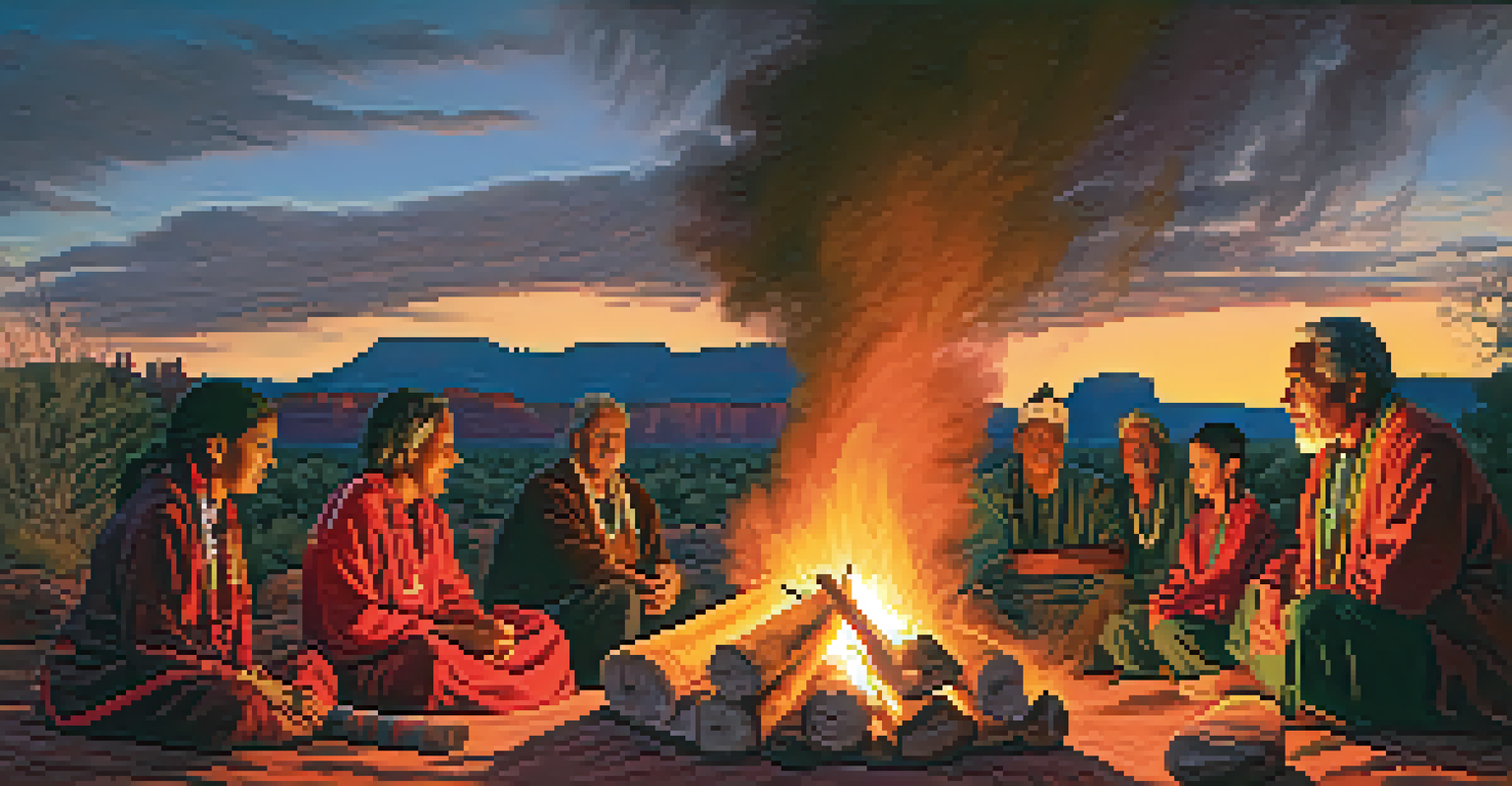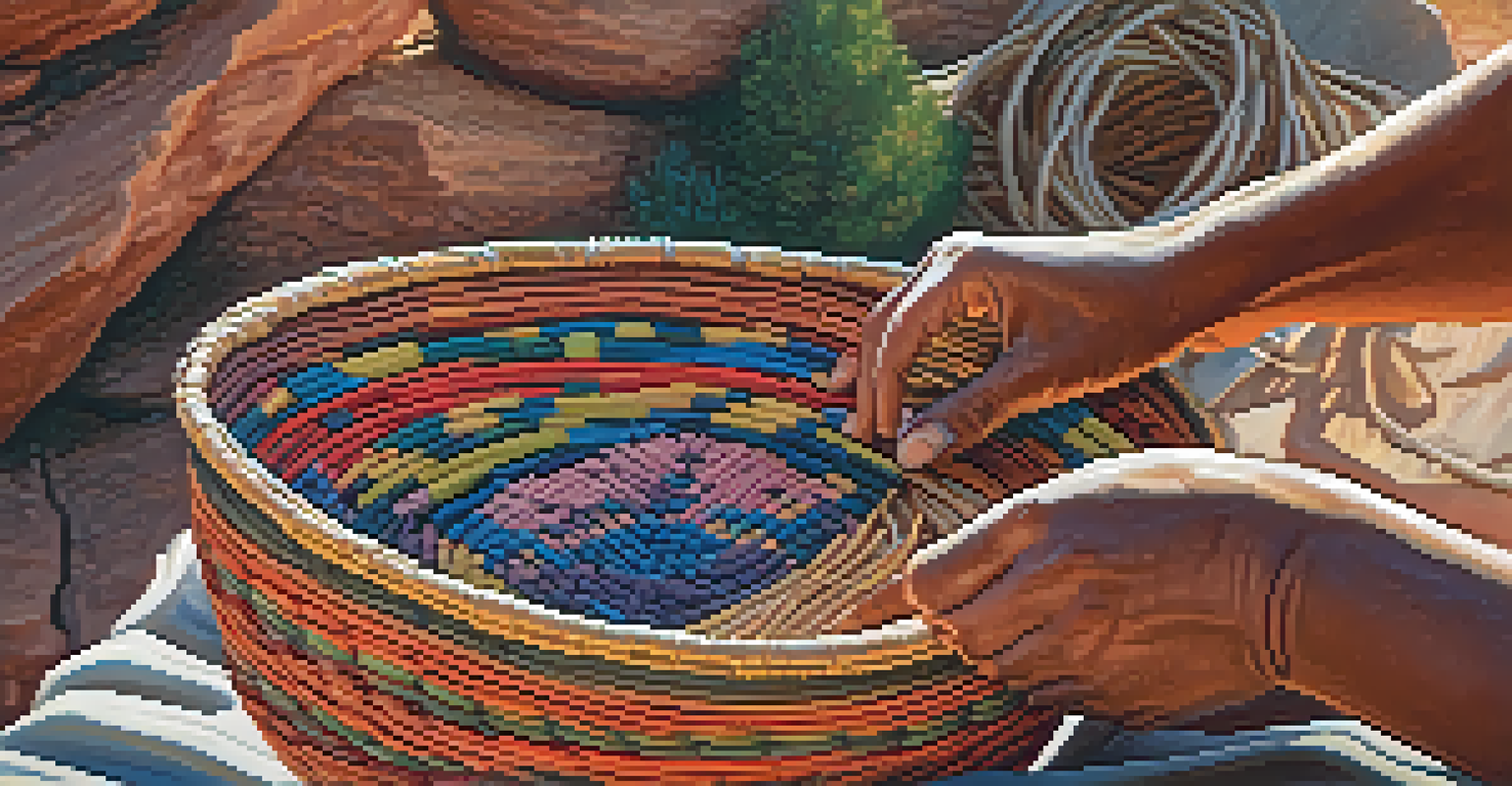Cultural Practices of Sedona's Indigenous Communities

Understanding the Indigenous Peoples of Sedona
Sedona, Arizona, is home to several Indigenous communities, primarily the Yavapai and Apache tribes. These groups have lived in harmony with the land for generations, developing a deep connection to its natural beauty. Their cultural practices reflect a profound respect for the environment, showcasing traditions that emphasize sustainability and community.
The land is the source of all life and the place where our stories are born.
The history of these communities is rich and complex, shaped by both their ancient roots and the challenges posed by colonization. Over the years, they have worked tirelessly to preserve their languages, stories, and customs. Today, many Indigenous people in Sedona strive to educate others about their heritage and the importance of their cultural identity.
Understanding the Indigenous peoples of Sedona is essential to appreciating the region's diverse cultural landscape. Their traditions not only enrich the local culture but also offer valuable lessons on living in balance with nature. This connection to the land continues to influence their practices and beliefs, making them an integral part of Sedona's identity.
Traditional Storytelling: A Window into Indigenous Culture
Storytelling holds a special place in Indigenous cultures, serving as a means to pass down knowledge, morals, and history. In Sedona, oral traditions are often shared during community gatherings, where elders impart wisdom to younger generations. These stories are more than entertainment; they are vital threads that weave together the fabric of their culture.

Themes in these narratives often emphasize the interconnectedness of all living beings, illustrating concepts such as respect for nature and the importance of community. Stories may feature animals, natural elements, or historical events, each carrying lessons that resonate with their audience. This practice not only preserves their heritage but also fosters a sense of belonging and identity.
Indigenous Heritage in Sedona
Sedona's Indigenous communities, primarily the Yavapai and Apache tribes, maintain a deep connection to the land through their cultural practices, storytelling, and craftsmanship.
The art of storytelling is a dynamic practice, evolving with each retelling while maintaining core values. It encourages listeners to reflect on their own lives and the world around them. Through storytelling, Sedona's Indigenous communities keep their culture vibrant, ensuring that their rich traditions endure for future generations.
Craftsmanship: Weaving Tradition into Art
Craftsmanship is another vital aspect of Sedona's Indigenous culture, with artisans creating beautiful works that reflect their heritage. Traditional crafts, such as pottery, basket weaving, and beadwork, showcase not only artistic skills but also cultural narratives. Each piece tells a story, often rooted in spiritual beliefs or historical events, connecting the present with the past.
To be a good steward of the earth, we must understand our connection to it.
The materials used in these crafts are often sourced from the local environment, further emphasizing the relationship between the Indigenous peoples and their land. For example, natural dyes from plants may be used to color woven baskets, linking the art to the earth itself. This practice not only supports sustainability but also reinforces cultural teachings about the importance of respecting nature.
In recent years, many artisans have begun to share their work with broader audiences through galleries and markets. This exposure helps to promote understanding and appreciation for Indigenous art. By valuing these traditional crafts, we acknowledge the creativity and resilience of Sedona's Indigenous communities, ensuring their artistic legacy continues to thrive.
Ceremonies: Celebrating Life and Nature
Ceremonial practices play a crucial role in the spiritual life of Sedona's Indigenous communities. These ceremonies often mark significant life events, such as births, marriages, and seasonal changes, connecting individuals to their cultural heritage and the natural world. Through rituals, participants seek to promote harmony and balance, reflecting their deep respect for the cycles of life.
Many ceremonies incorporate music, dance, and storytelling, creating a rich tapestry of cultural expression. For instance, seasonal ceremonies may celebrate the arrival of spring or the harvest, bringing the community together in joyous recognition of nature's gifts. These gatherings foster a sense of unity and collective identity among participants.
Storytelling as Cultural Preservation
Oral traditions in Sedona's Indigenous cultures serve as vital means to pass down knowledge and foster community identity, emphasizing respect for nature and interconnectedness.
Participation in these ceremonies not only strengthens community bonds but also provides an opportunity for cultural transmission. Elders often lead these events, sharing their knowledge and wisdom with younger generations. In this way, Sedona's Indigenous ceremonies serve as vital moments of connection to both the past and the future.
Connection to the Land: A Spiritual Perspective
For Sedona's Indigenous communities, the land is not just a physical space but a living entity imbued with spiritual significance. Mountains, rivers, and other natural features are often viewed as sacred, embodying the spirits of ancestors and serving as sites for spiritual practices. This deep connection to the land shapes their worldview and informs their cultural practices.
Many Indigenous stories and teachings emphasize the importance of stewardship, encouraging respect for the environment. This perspective is particularly relevant in today's context of environmental challenges, as it promotes sustainable living and a harmonious relationship with nature. By prioritizing this connection, the community embodies a model of ecological responsibility.
The reverence for the land is also reflected in their practices, such as traditional agriculture and foraging. These methods not only sustain the community but also foster a sense of gratitude for the earth's resources. Through this relationship, Sedona's Indigenous peoples remind us of the importance of nurturing our environment and recognizing our place within it.
Language: The Heartbeat of Cultural Identity
Language is a crucial aspect of cultural identity for Sedona's Indigenous communities. It serves as a vessel for passing down traditions, stories, and values from one generation to the next. Unfortunately, many Indigenous languages face the threat of extinction, making revitalization efforts increasingly important.
In Sedona, community members have initiated programs to teach younger generations their ancestral languages. These efforts often include immersive experiences and the incorporation of language into everyday life. By fostering fluency, they not only preserve their heritage but also strengthen their cultural identity.
Education for Cultural Understanding
Community-led educational initiatives in Sedona aim to bridge cultural gaps and promote inclusivity by teaching both Indigenous and non-Indigenous people about local heritage and traditions.
The power of language extends beyond communication; it shapes one's worldview and connection to culture. Through language, Indigenous peoples express their relationship with the land, community, and spirituality. As such, revitalizing these languages is a vital step in ensuring the survival of Sedona's rich cultural tapestry.
Modern Influences: Balancing Tradition and Change
As Sedona continues to grow, Indigenous communities face the challenge of balancing their traditional practices with the influences of modern society. While some may see change as a threat to their culture, many community members view it as an opportunity for adaptation and growth. This balance allows them to maintain their identity while engaging with the wider world.
Modern technology and social media have provided platforms for Indigenous voices to be heard and celebrated. Many individuals use these tools to share their stories, art, and cultural practices, fostering a greater understanding and appreciation of their heritage. This visibility helps bridge cultural divides and create connections with people beyond their community.

However, with modernization comes the risk of cultural appropriation and misunderstanding. It is essential for both Indigenous peoples and the wider community to engage in respectful dialogue, ensuring that traditions are honored and not exploited. By fostering this understanding, Sedona's Indigenous communities can navigate the complexities of modern life while preserving their rich cultural legacy.
Preserving Heritage: The Role of Education and Community Initiatives
Education plays a vital role in preserving the cultural heritage of Sedona's Indigenous communities. Community-led initiatives aim to teach both Indigenous and non-Indigenous people about the rich history, traditions, and values of these groups. By fostering understanding and respect, these programs help to bridge cultural gaps and promote inclusivity.
Schools and community centers often host workshops, cultural events, and storytelling sessions that invite participation from all ages. These activities not only celebrate Indigenous culture but also provide opportunities for personal connections and shared experiences. Such initiatives empower Indigenous youth to take pride in their heritage and inspire others to appreciate it.
Moreover, partnerships with local organizations and institutions can amplify these efforts, leading to greater visibility and support for Indigenous issues. By working together, Sedona's Indigenous communities and allies can create a more inclusive society that honors and preserves their rich cultural traditions for generations to come.